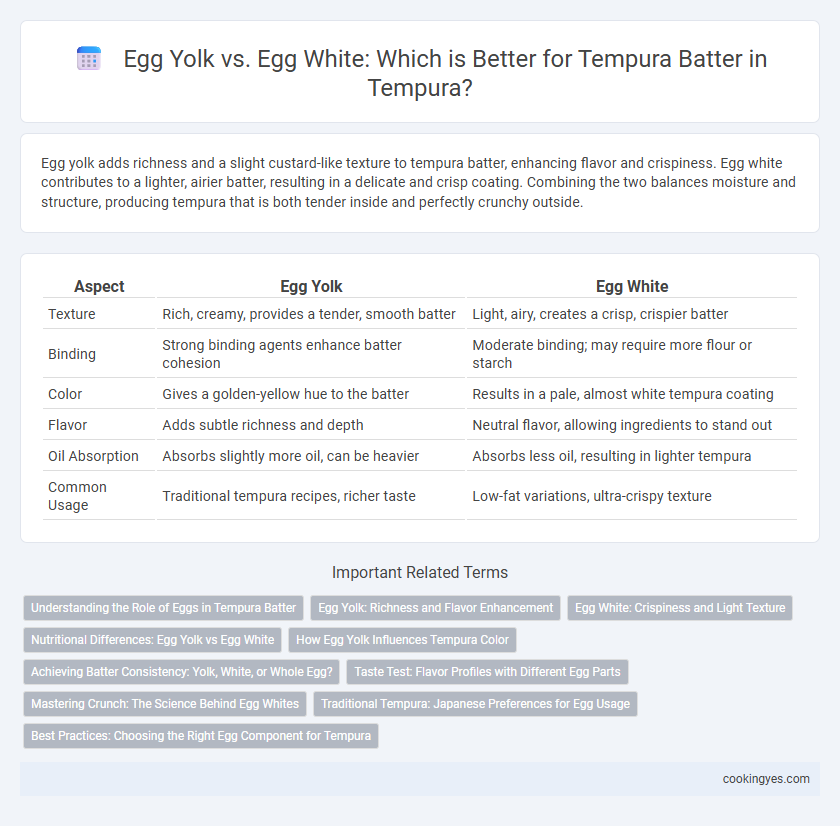Egg yolk adds richness and a slight custard-like texture to tempura batter, enhancing flavor and crispiness. Egg white contributes to a lighter, airier batter, resulting in a delicate and crisp coating. Combining the two balances moisture and structure, producing tempura that is both tender inside and perfectly crunchy outside.
Table of Comparison
| Aspect | Egg Yolk | Egg White |
|---|---|---|
| Texture | Rich, creamy, provides a tender, smooth batter | Light, airy, creates a crisp, crispier batter |
| Binding | Strong binding agents enhance batter cohesion | Moderate binding; may require more flour or starch |
| Color | Gives a golden-yellow hue to the batter | Results in a pale, almost white tempura coating |
| Flavor | Adds subtle richness and depth | Neutral flavor, allowing ingredients to stand out |
| Oil Absorption | Absorbs slightly more oil, can be heavier | Absorbs less oil, resulting in lighter tempura |
| Common Usage | Traditional tempura recipes, richer taste | Low-fat variations, ultra-crispy texture |
Understanding the Role of Eggs in Tempura Batter
Egg yolks contribute richness and a creamy texture to tempura batter, enhancing flavor and helping create a tender, golden crust by binding fats and moisture. Egg whites emphasize lightness and crispiness, producing an airy batter that crisps quickly and evenly during frying. Balancing yolk and white proportions is key to achieving the ideal tempura texture--crisp yet delicate, with optimal oil absorption and minimal greasiness.
Egg Yolk: Richness and Flavor Enhancement
Egg yolk enhances tempura batter by adding richness and depth of flavor, resulting in a golden, crispy texture. Its natural fats improve the batter's emulsification, creating a light yet flavorful coating that complements seafood and vegetables. Using egg yolk in tempura batter intensifies the taste, making each bite more satisfying and aromatic compared to using only egg whites.
Egg White: Crispiness and Light Texture
Egg white in tempura batter enhances crispiness and creates a light, airy texture by incorporating more proteins that form a delicate, crunchy crust when fried. The lean composition of egg whites minimizes oil absorption, resulting in a less greasy, crisp finish that highlights the fresh flavors of the ingredients. This approach is favored in traditional Japanese tempura recipes for its ability to produce a tender yet crisp coating that complements seafood and vegetables.
Nutritional Differences: Egg Yolk vs Egg White
Egg yolk in tempura batter provides higher levels of fat, vitamins A, D, E, and essential minerals like iron, contributing to richer flavor and texture. Egg white offers a low-calorie, high-protein option with minimal fat and cholesterol, creating a lighter, crispier tempura coating. Choosing egg yolk enhances nutrient density, while egg white supports a leaner, more delicate batter.
How Egg Yolk Influences Tempura Color
Egg yolk adds a rich golden hue to tempura batter, enhancing the visual appeal with a warm, appetizing color compared to egg white's paler result. The natural pigments and fats in egg yolk caramelize during frying, contributing to a deeper, crispier crust. This color transformation not only signifies proper cooking but also signals a richer flavor profile in the finished tempura.
Achieving Batter Consistency: Yolk, White, or Whole Egg?
Egg yolks contribute richness and help bind tempura batter, resulting in a thicker, more cohesive coating, while egg whites provide a lighter, crispier texture due to their protein structure creating airy bubbles. Using whole eggs balances these effects, offering moderate binding and crunch ideal for consistent batter thickness. The choice between yolk, white, or whole egg impacts the batter's viscosity and final tempura texture, influencing how well the batter adheres and fries evenly.
Taste Test: Flavor Profiles with Different Egg Parts
Egg yolk in tempura batter adds richness and a subtle creaminess, enhancing depth of flavor with a slightly savory undertone. Egg white creates a lighter, crispier texture, providing a delicate crunch without overpowering the natural taste of the ingredients. Taste tests reveal that yolk-based batter offers a fuller flavor profile, while egg white relies on crispiness and neutrality to complement the tempura's freshness.
Mastering Crunch: The Science Behind Egg Whites
Egg whites enhance tempura batter by creating a lighter, crunchier texture due to their high protein content, which forms a delicate structure upon frying. The absence of fat in egg whites allows the batter to crisp faster, locking moisture inside the tempura while maintaining a golden, airy crust. Mastering the use of egg whites in tempura batter is key to achieving the ideal balance between crunchiness and lightness prized in authentic Japanese cuisine.
Traditional Tempura: Japanese Preferences for Egg Usage
Traditional Japanese tempura batter typically emphasizes the use of egg yolk over egg white due to its ability to create a richer, silkier texture that enhances the light, crisp coating essential to authentic tempura. Egg yolk contributes emulsifying properties and adds a subtle depth of flavor, which aligns with the Japanese culinary principle of balancing delicate tastes while maintaining a crisp exterior. In contrast, egg white tends to produce a lighter, airier batter but is less favored in traditional tempura recipes for lacking the nuanced mouthfeel and stability provided by yolk-based mixtures.
Best Practices: Choosing the Right Egg Component for Tempura
Egg yolk adds richness and a tender texture to tempura batter, resulting in a crispy yet slightly creamy coating. Egg white contributes to a lighter, crispier shell with enhanced crunch, ideal for delicate tempura items like shrimp or vegetables. For optimal tempura batter, many chefs balance yolk and white ratios or use primarily egg white for a crisp finish while incorporating yolk for flavor and binding.
Egg yolk vs Egg white for Tempura batter Infographic

 cookingyes.com
cookingyes.com